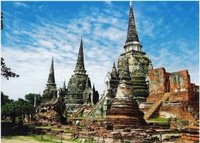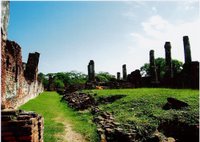Chedis at Wat Phra Si Sanphet, Ayuthaya



On the morning of Dec 7 2005, I boarded the wrong train from Bangkok's Hualumphong main station that wouldn't stop at Ayuthaya, the Siamese royal capital from 1350 to 1767. About an hour after the train pulled out of Bangkok, a conductor informed me the unbearable news that I had to get off the train and followed the track to the closest station. I mistakenly got on a delayed train that was held at the same platform as the one that would take me to Ayuthaya. Thai rail service is not reliable in the regard that change of departure time is often unannounced.
Arrival in Ayuthaya shortly after 10 am. I walked down the street through the old city flanked by food stalls and shops to the river. I took a short ferry ride for 2B (US$1 = 40B). For touring the ruins under such scorching weather, the most economical option is to rent a bike from one of the nearby guesthouses for 30B a day.
Wat Phra Si Sanphet was the largest temple in Ayuthaya in its time and it was used as the royal temple and palace for several Ayuthaya kings. It was used for royal ceremonies and rituals including giving alms to the monks from other temples, and performing the Wian Tian ceremony on Buddhist holy days, which entails circumambulating the Viharn three times at night holding an offering of a candle, flowers and incense.
Built in the 14th century, Wat Phra Si Sanphet once contained a 50 feet-high standing Buddha covered with 500 lbs of gold, which was melted down by the Burmese conquerors when these invaders sacked Ayuthaya in 1767. Wat Phra Si Sanphet is now mainly known for the line of three large chedi (stupas) erected in the quintessential Ayuthaya style. The remains of ceramic water pipes were found in the grounds of this temple, testimony to the architectural and cultural advances in the old days.
0 Comments:
Post a Comment
<< Home